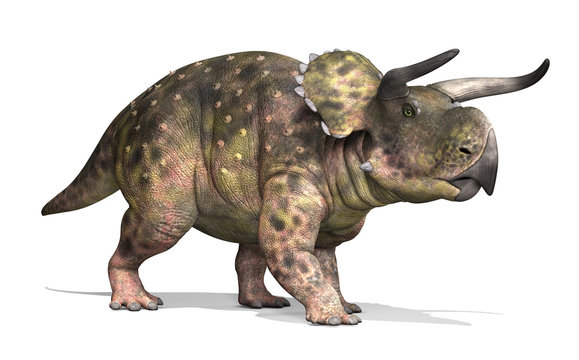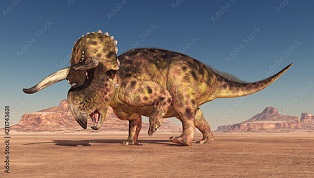
Nasutoceratops Dinosaur also known as Nasutuceratops or "big-nose horned face," is a fascinating genus of ceratopsid dinosaur that lived during the Late Cretaceous period, approximately 76 to 75 million years ago. Its discovery has provided significant insights into the diversity and evolution of horned dinosaurs.
The first fossils of Nasutoceratops were discovered in the Grand Staircase-Escalante National Monument in southern Utah, USA, in 2006. The initial discovery included a partial skull, portions of the frill, and some postcranial elements. Subsequent excavations in the area have revealed additional specimens, including more complete skulls and various skeletal elements. Paleontologists have been able to piece together a significant amount of information about Nasutoceratops from these fossil remains, providing valuable data for understanding the biology and evolution of this unique dinosaur.
| Name: | Nasutoceratops dinosaurs |
| Size: | Around 4.5 to 5.5 meters (15 to 18 feet) |
| Main Facts: | Nasutoceratops is known for its long, forward-curved nose horn, making it unique among horned dinosaurs. |
Nasutoceratops' most striking feature was its long and forward-curved nose horn. Additionally, it had short, curved brow horns above its eyes and a relatively short frill with triangular fenestrae (openings) in the frill bones. The frill likely served as a display structure and may have played a role in communication and species recognition.

During the Late Cretaceous, the region where Nasutoceratops lived was a vast floodplain with a diverse ecosystem. This area was teeming with a variety of dinosaurs, including other horned dinosaurs, hadrosaurs, and theropods like Tyrannosaurus rex.
Nasutoceratops shared its environment with other ceratopsids, such as Utahceratops and Kosmoceratops, each of which had unique cranial features and adaptations. These coexisting horned dinosaurs likely occupied different ecological niches, reducing competition for resources and enabling a diverse ecosystem to thrive.
Nasutoceratops was a large dinosaur, estimated to be around 4.5 to 5.5 meters (15 to 18 feet) in length, and it likely weighed between 1.8 to 2.7 tons. Its most distinctive feature, as suggested by its name, was its long and impressive nose horn. The nasal horn curved forward, giving the dinosaur a unique appearance among other horned dinosaurs.
This herbivorous dinosaur was part of the ceratopsid family, a group of quadrupedal, beaked, and frilled dinosaurs known for their elaborate cranial ornamentation. Nasutoceratops belonged to the subgroup of chasmosaurine ceratopsids, characterized by long brow horns and short frills
The most distinct feature of Nasutoceratops is its long, forward-curved nasal horn, which sets it apart from other horned dinosaurs like Triceratops, whose nasal horn points backward.
Nasutoceratops had a relatively short frill compared to some other chasmosaurine ceratopsids like Pentaceratops or Triceratops, which had larger and more elaborate frills.
The brow horns in Nasutoceratops were relatively short and curved, contrasting with the long and straight brow horns seen in Triceratops.
Nasutoceratops shares its habitat with another unique ceratopsid, Kosmoceratops. While both have unique cranial features, Kosmoceratops possesses 15 different horns and frills, making it one of the most ornamented dinosaurs known.
Nasutoceratops was a moderately large dinosaur, but it was smaller than some other ceratopsids like Triceratops, which could reach lengths of over 9 meters (30 feet) and weigh up to 10 tons.
Nasutoceratops fossils have been found in southern Utah, while other horned dinosaurs were distributed in different regions across North America and Asia.